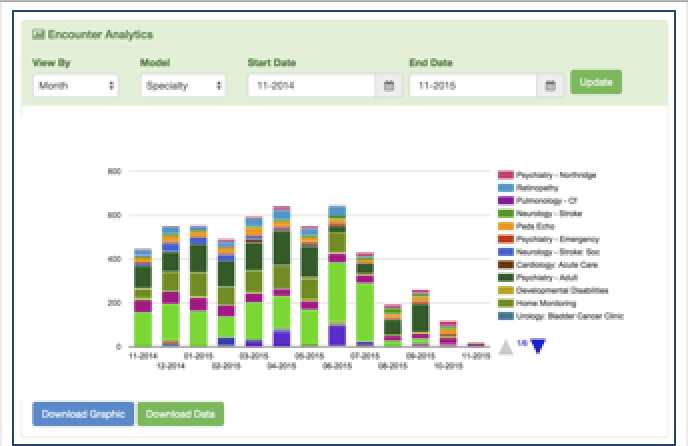Why is Performance Reporting a Critical Success Factor for Telehealth Programs?
Increasing availability of telehealth software, medical devices, and clinical services is an important component for achieving the triple aim in US healthcare systems. Telehealth adoption has accelerated across the industry because of:
- Favorable reimbursement
- Aligned government regulations
- Increasing body of positive medical evidence
- Patient and provider acceptance
In order to scale and sustain this growth, healthcare organizations need to report more than just the number of patient telehealth consults. Moving forward, greater enterprise accountability is critical to prioritizing future investments in telehealth services, staffing and technology – with transparency of:
- Measured performance in operational efficiency
- Patient safety
- Improved medical outcomes
What is the current state of Enterprise Telehealth Performance Reporting?
Plenty of siloed data: Recent investments in digital health records, enterprise data warehouses, and other health IT infrastructure have focused on separate inpatient and outpatient “in person” care. Telemedicine consultations and other community-based virtual care data have been siloed without contributions or visibility in enterprise 360-degree reports of cost, efficiency and quality of patient care. Virtual care documentation can be limited and variable. Often virtual care is not even coded if it is not being reimbursed, and may only be manually tracked and fragmented by service lines or clinical departments – without an enterprise view or economies of scale.
Lack of automated tracking: As a result, telehealth data is often not included or identified (coded) in the enterprise data warehouse repositories or EHR’s, and therefore not represented in routine or ad hoc performance reports. This results in under representation and prioritization of telehealth services in the value-based, enterprise budget process.
The Path Forward – standardization and what do you measure?
Next step – data transparency: Telehealth programs can only be fully integrated and financially supported at scale, when their value is better documented, included, and highlighted in enterprise and departmental performance reports.
Data governance and documentation standardizationRecent advancements in multi-service line, enterprise-wide telehealth platforms leverage:
- Consistent data governance for enhanced data sharing
- Structured & branching logic documentation for improved workflows
- Procedure and diagnostic coding of telehealth services for reimbursement
Modern telehealth platforms support efficient workflows, combined with real-time EHR and virtual visit data aggregation. This results in:
- Better patient access with less need to transfer “out of network” for specialty care
- Timely and more accurate clinical decision-making
- Enhanced patient safety
- Clinical operational efficiency
- Improved patient and provider satisfaction
Automated Performance Dashboards: Embedding configurable clinical and administrative reporting tools into an enterprise telehealth platform with import and export connections enables consistent access to real-time dashboards and reporting services. This integrated, layered platform, data sharing framework delivers a patient-centered, comprehensive performance situational awareness – across care settings and delivery modalities.
Process and Outcome Metrics: Internal and external key performance indicators for dashboards and reports are emerging, as payment models shift from fee-for-service, volume-based to value-based, quality outcome alternative reimbursement incentives. Enterprise balanced scorecards emphasize telehealth measures of:
- Operational efficiency/productivity & process
- Medical outcomes
- Patient safety
- Service satisfaction
The National Quality Forum has published its framework for measure development for telehealth benchmarking enabling comparative analysis for patients, providers, governments and payers.
Conclusion
While hospitals and Integrated Delivery Networks (IDN) have embraced telehealth services in their networks, only now are some beginning to harness the incremental value of this new data when it is properly integrated in their enterprise health IT infrastructure.
Leveraging the enterprise telehealth platform to capture, aggregate, display, store, transport, and evaluate virtual visit encounter data provides the critical foundation for telehealth data analytics today and into the foreseeable future.
Prepared by Dr. Richard Bakalar, MD, FATA






